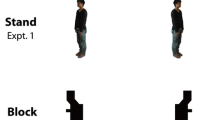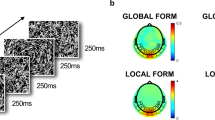Abstract
This article summarizes some research on the development of motion perception in early infancy. The sensitivity for slow and rapid motion was studied with 1-month-old and 3-month-old babies. The findings suggest that there are different developmental courses for the detection of slow and rapid motion. The ability to detect very slow motion seems to improve gradually with age whereas the sensitivity for very rapid motion seems to be at a level comparable to adults soon after birth. Three-month-old babies do use kinetic visual information in order to perceive object boundaries and form. After having seen a form visible only when moving they are able to “identify” the same form when seeing it under static conditions. Infants and young children do use kinetic visual information for recognizing figures that are never completely in sight only if they have been familiarized with the fully visible form first. Even 4-year-olds have difficulties in perceiving the full form of a figure that moves behind a slit in an opaque occluding surface if there is no familiarity or “priming” with the global form first. In conclusion, infants are able to detect visual motion very early in life and do extract information which leads to the perception of form. However, this ability may be limited to events with uninterrupted, continuous movement of visible elements.
Similar content being viewed by others
References
Banks MS, Salapatek P (1983) Infant visual perception. In: Mussen PH (ed) Handbook of child psychology, Vol. 2. Wiley, New York, pp 435–671
Bonnet C (1977) Visual motion detection models: features and frequency filters. Perception 6: 491–500
Bronson GW (1974) The postnatal growth of visual capacity. Child Dev 45: 873–890
Bronson GW (1982a) The scanning patterns of human infants. Ablex, Norwood, NJ
Bronson GW (1982b) The structure, status, and characteristics of the nervous system at birth. In: Stratton PM (ed) The psychobiolgy of the human newborn. Wiley, London, pp 99–114
Granrud CE, Yonas A, Smith IM, Arterberry ME, Glicksmann ML, Sorknes AC (1984) Infants' sensitivity to accretion and deletion of texture as information for depth at an edge. Child Dev 55: 1630–1636
Green M (1981) Psychophysical relationship among mechanisms sensitive to pattern, motion and flicker. Vision Res 21: 971–983
Hartmann EE, Banks MS (1984) Development of temporal contrast sensitivity. Paper presented at the International Conference on Infant Studies, New York
Heck J, Zetterstroem B (1958) Analyse des photopischen Flimmererlektroretino-gramms bei Neugeborenen. Ophthalmology 135: 205–210
Helmholtz H von (1867) Handbuch der physiologischen Optik. Voss, Leipzig
Kaufmann F, Stucki M, Kaufmann-Hayoz R (1985) Development of infants' sensitivity for slow and rapid motions. Infant Behav Dev 8: 89–98
Kaufmann-Hayoz R (1991) Perceptual development. In: Lamb ME, Keller H (eds) Infant development. Erlbaum, Hillside, NJ pp 219–243
Kaufmann-Hayoz R, Kaufmann F, Stucki M (1986) Kinetic contours in infants' visual perception. Child Dev 57: 292–299
Kulikowski JJ, Tolhurst DJ (1973) Psychophysical evidence for sustained and transient channels in human vision. J Physiol 232: 149–163
Regal DM (1981) Development of critical flicker frequency in human infants. Vision Res 21: 549–555
Rock I (1983) The logic of perception. MIT Press, Cambridge, MA
Author information
Authors and Affiliations
Rights and permissions
About this article
Cite this article
Kaufmann, F. Development of motion perception in early infancy. Eur J Pediatr 154 (Suppl 4), S48–S53 (1995). https://doi.org/10.1007/BF02191506
Issue Date:
DOI: https://doi.org/10.1007/BF02191506




